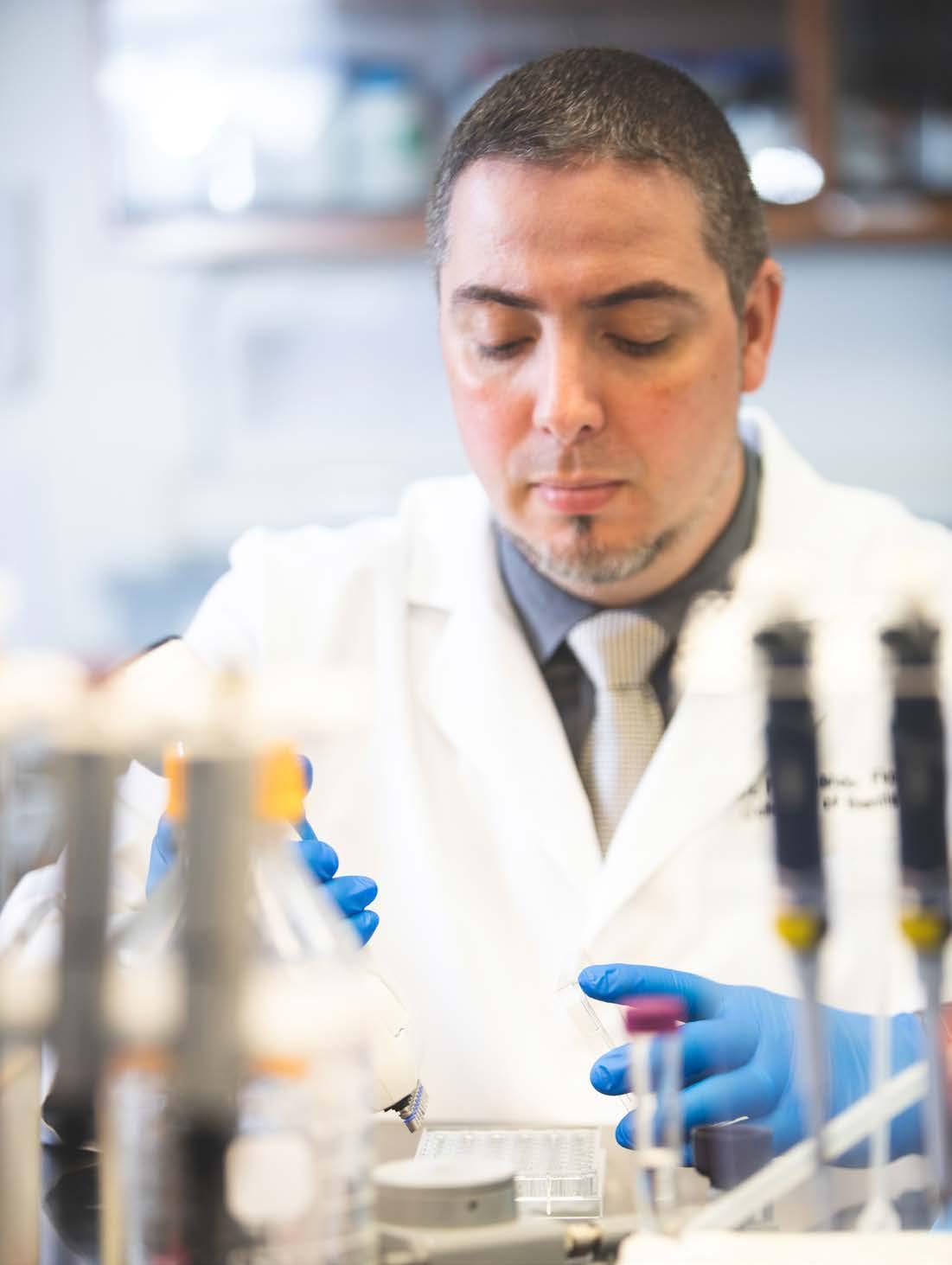
4 minute read
Research
“If we can find a way to replace a tooth-colored filling every 14 years instead of every seven years, we can reduce the cost of oral healthcare and save more of the patients’ tooth structure,” Dr. Khajotia said.
Tooth-colored fillings contain chemical bonds called ester bonds. The saliva in a person’s mouth contains enzymes called esterases. Dr. Khajotia’s study focuses on the esterases in saliva that have the ability to break the ester bonds in tooth-colored fillings. His previous studies have shown that when the bonds break down, the surface of the filling begins to degrade and becomes rougher, which allows more plaque to form.
Because filling material contains many different components, Dr. Khajotia wants to understand which of them are linked to more or less plaque formation. If individual components can be isolated, filling materials might be changed so that they don’t support as much plaque growth.
“This represents a gap in our knowledge in dentistry,” he said. “We don’t know precisely what is happening to these fillings at the junction between tooth structure, the filling material and what we call a bonding agent. It’s a complex interface, but we are beginning to learn more about why these fillings fail earlier than they should.”
College Researcher Earns Grant to Seek Longer-Lasting Tooth-Colored Fillings
When dentists discover cavities in their patients, they are often filled with a tooth-colored material that looks just like a person’s own teeth.
However, tooth-colored fillings usually require replacement every five to seven years, often because tooth decay has formed under the filling. A researcher at the OU College of Dentistry in Oklahoma City is investigating which components of filling materials are most susceptible to decay and which enzymes in a person’s saliva cause the most plaque.
Sharukh S. Khajotia, B.D.S., Ph.D., associate dean for research, recently received a grant from the National Institutes of Health to further his investigations into decay and tooth-colored fillings. Although filling materials have improved considerably since the 1960s, it is estimated that in the United States alone, more than $5 billion is spent each year on restoring and replacing fillings, he said. Dr. Khajotia has been building his research over the years to the point where he earned the recent federal grant. In previous research funded locally by the Presbyterian Health Foundation and the Oklahoma Center for the Advancement of Science and Technology, he studied how two saliva enzymes degrade fillings. The new grant expands that research. He is using tests that he and his team developed and that are now being used around the world, including a process for creating a three-dimensional structure of plaque.
The new grant also includes funding for several dental and dental hygiene students to participate in the research, a process that benefits them greatly as they begin their careers.
“Patient care and research go hand in hand; without one, you cannot have the other,” Dr. Khajotia said. “Most of the developments in dental biomaterials have been based on a clinical need. Our college has a history of clinical excellence, so doing research is a logical extension of our clinical capabilities.”
Fighting Back Against Bacteria on Dental Restorations
asked themselves: What if the adhesive resins used in restorative dentistry could not only bond a filling to the tooth, but also could fight against bacteria that attack the filling?
The solution they proposed was the utilization of nitrogen-doped titanium dioxide nanoparticles.
“A nanoparticle can be 750 times smaller than the thickness of a human hair,” Dr. Khajotia said. “The properties of many conventional materials change when formed from nanoparticles because they have a great surface-to-volume ratio compared to larger particles.”
Dr. Esteban Florez and Dr. Khajotia determined they needed to construct higher-quality nanoparticles and make them functional within dental polymers to create the adhesive resin. Toward this end, they established a collaboration with Adam Rondinone, Ph.D., a scientist from the Center for Nanophase and Materials Sciences at Oak Ridge National Laboratory in Oak Ridge, Tennessee.

This multidisciplinary team started to fabricate nitrogen-doped titanium dioxide nanoparticles using robust synthesis processes based on the production of chemical compounds, known as solvothermal reactions. Unlike other adhesive resins, the materials developed display antibacterial properties, which are enhanced by on-demand light irradiation.
The research looks promising, and the team is hopeful about its translation into clinical practice. For now, it has led to other findings, such as the nanoparticles’ ability to produce crystals containing high concentrations of phosphorous and calcium from saliva-like solutions.
Most people don’t look forward to going to the dentist, especially when continually replacing fillings and crowns. What if there was a secret weapon fighting the bacteria that causes dental restorations to fail? The team investigated the nanoparticles using cutting-edge scientific technologies available at Oak Ridge, including time-of-flight secondary ion spectrometry, small-angle x-ray spectroscopy, small-angle neutron scattering and advanced microscopies.
Fernando Luis Esteban Florez, D.D.S., M.S., Ph.D., and Sharukh Khajotia, B.D.S., M.S., Ph.D., are on the forefront of developing that secret weapon.
The traditional procedure used to place composite fillings involves several steps, but before the placement, an adhesive resin must be applied to bond the tooth to the filling. The disadvantage is that cavities can recur over time as a result of biofilm—a pool of various bacteria—seeping into micro cracks of a restoration. Because of this common problem, Dr. Esteban Florez and Dr. Khajotia “Using neutron scattering, we can understand how well the nanoparticles are dispersed, how they impact polymer chains, and what types of interfaces are established between the polymer and nanoparticles,” Dr. Esteban Florez said.
Today, the research team holds two patents. Current research into functionalizing the nanoparticles in areas other than dentistry, including antibacterial coatings for the control of cross-contamination in hospitals, is ongoing.










